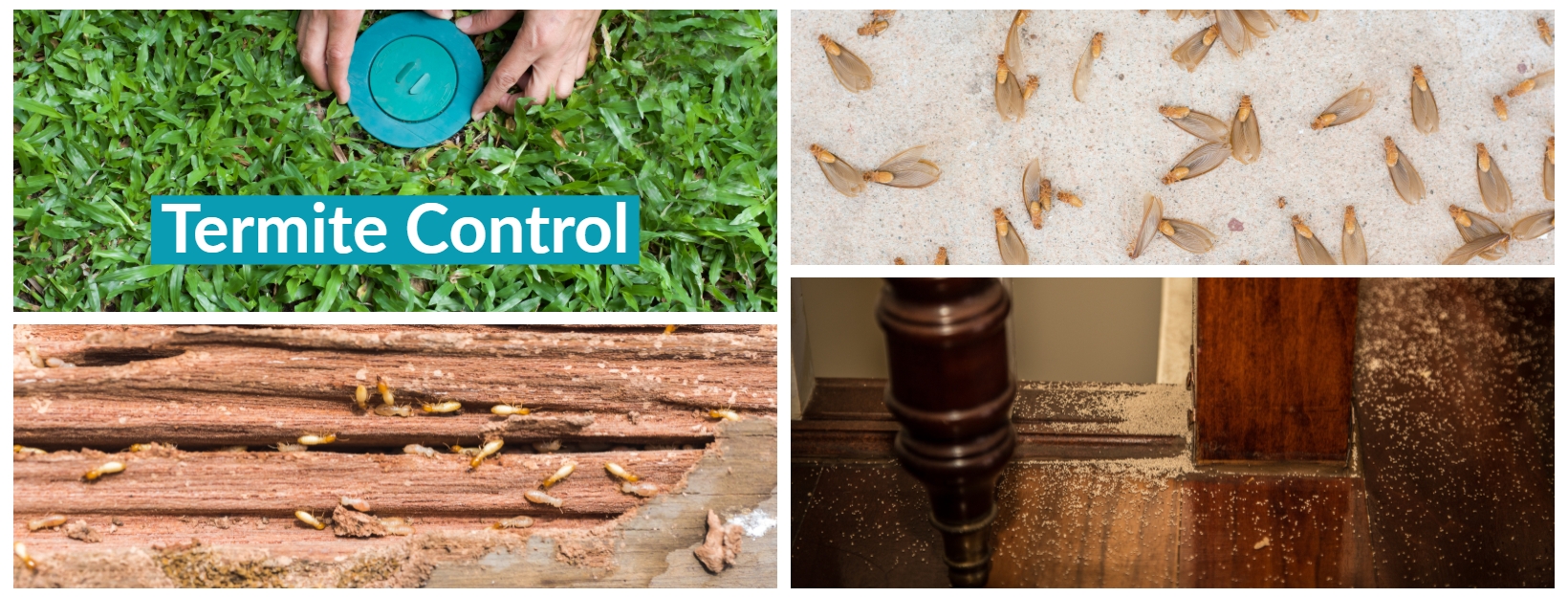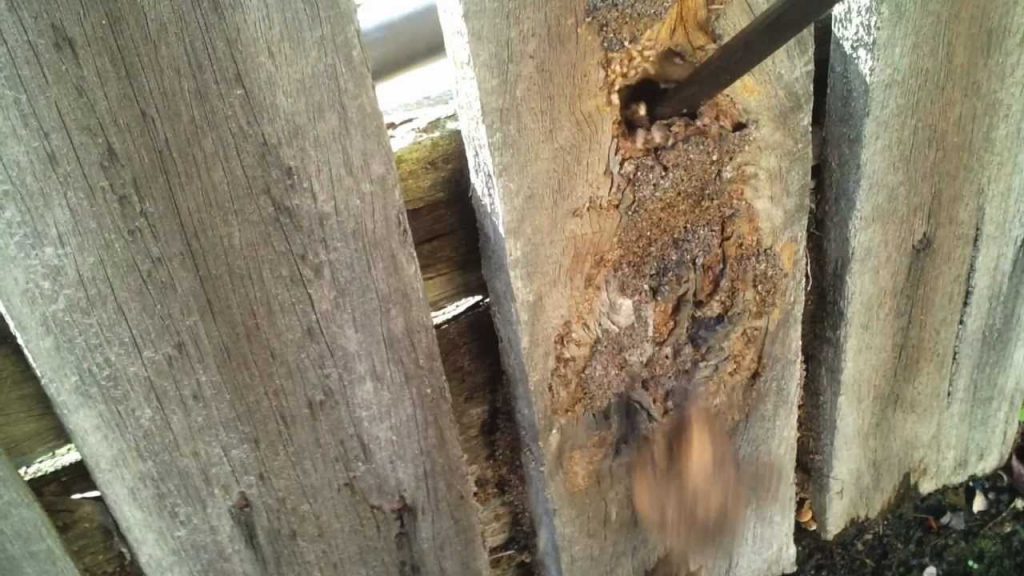Termites are one of the most destructive pests that can attack the wooden structures of your property. Left unchecked, a termite infestation can quickly weaken and damage your fence, potentially leading to costly repairs or replacement. In this article, we’ll discuss how to spot and treat termites in your fence before it’s too late.
Types of Termites

- Dampwood Termites: These termites are found in wood with high moisture content, such as wood that has been exposed to water or a damp environment. They are also known as the Pacific dampwood termite.
- Drywood Termites: These termites live in dry wood and are found in warmer climates. They do not need moisture to survive and can cause significant damage to homes and wooden structures.
- Subterranean Termites: These termites live in colonies underground and travel to the surface to feed on wood. They require moisture to survive and can cause severe damage to homes and wooden structures.
- Formosan Termites: These termites are an invasive species that originate from Asia. They are a destructive species and are capable of causing severe damage to homes and wooden structures.
Signs of Termites in Fences

Fences are susceptible to termite damage because they are often made of wood. The signs of termites in fences will vary depending on the severity of the infestation and the type of wood used for the fence’s construction.
When inspecting for signs of termites in fences, one of the most common indicators is the appearance of mud tubes. These tubes are created by worker termites as they travel between the soil and the wood. They are usually grayish-brown in color and can be found along the base of the fence.
Another common sign of termites in fences is the presence of holes, which may be small and round or larger and irregularly shaped. This is caused by the termites eating through the wood in order to gain access to food sources.
Additionally, the presence of frass (termite droppings) is also a sign of a termite infestation. These droppings are often small, black pellets that can accumulate along the base of the fence or near the holes termites create.
Finally, if the infestation is severe enough, the wood in the fence may begin to sag or buckle. This is a sign that the termites have begun to cause structural damage to the wood.
If you suspect that your fence may be infested with termites, it is important to contact a pest control professional to inspect the area and determine the best course of action.
Prevention of Termites

- Remove any sources of moisture from around the fence line.
- Check for any signs of termite activity on a regular basis.
- Maintain a gap of at least six inches between the soil and the fencing.
- Treat the wood with a termite-resistant solution.
- Install physical barriers, such as a sand barrier, to keep termites away.
- Regularly trim back any overhanging tree branches or shrubs.
- Store firewood and mulch away from the fence line.
- Repair any cracks or crevices in the fence.
- Inspect any nearby stumps for signs of termite activity.
Treatment of Termites

- Inspect the fence and identify the type of termite present.
- Choose appropriate treatment method based on the type of termite present.
- Use chemical treatments such as liquid termiticides, bait stations, and foam treatments.
- Apply termiticides directly to the fence, paying special attention to the areas where the wood meets the soil.
- Install a physical barrier like a metal sheathing to prevent termites from gaining further access.
- Remove wood debris and organic materials around the fence.
- Maintain healthy levels of moisture in the soil near the fence.
- Check the fence periodically to ensure that the termite population has been eliminated.
Do-It-Yourself Methods for Getting Rid of Termites

- Inspect your fence for signs of termite activity and remove any infested wood.
- Cut the fence posts and remove the wood from the area.
- Spray the area with an insecticide like bifenthrin.
- Check the fence regularly for signs of termites and repeat the process if necessary.
- Try diatomaceous earth as a natural way to kill termites.
- Use a termite-baiting system to attract and kill termites.
- Remove any sources of food or water for the termites, such as wood piles or standing water.
- Repair any cracks or gaps in your fence to prevent termites from entering.
- Inspect your fence regularly and call a professional if you suspect a termite infestation.
Professional Treatment for Termites

| Method | Advantage | Disadvantage |
|---|---|---|
| Chemical Barrier | Effective, long lasting | Expensive to install |
| Bait Stations | Low impact on environment, no digging | May require multiple visits from pest control |
| Heat | Non-toxic, no drilling | May not reach all termites, not effective for large infestations |
| Fumigation | Kills entire colony, no drilling | Toxic, expensive, may not reach all termites |
Chemical Barrier involves applying a chemical to the soil around the fence to form a barrier that repels termites. This method is effective and long lasting, but it is also expensive to install.
Bait Stations are placed in the ground near the fence, and when termites feed on the bait, they die. This method has a low impact on the environment and does not require digging, but it may require multiple visits from a pest control professional.
Heat treatment involves heating the soil around the fence to a very high temperature, killing the termites. This is a non-toxic method that does not require drilling, but it may not reach all termites in the colony and is not effective for large infestations.
Fumigation involves releasing a gas that penetrates the soil and kills the termites. This method can kill the entire colony, does not require drilling, but it is toxic and expensive, and may not reach all the termites.
Pros and Cons of Professional Treatment
| Pros | Cons |
|---|---|
|
|
Costs of Professional Treatment
- Inspection fee: A licensed termite inspector will conduct a thorough inspection of your fence and surrounding areas. This fee may vary depending on the size and scope of the inspection.
- Thermal Fumigation: This treatment is most commonly used for drywood termites. It involves heating the affected area to a temperature that is lethal for termites. The cost of this treatment may vary depending on the size of the affected area.
- Chemical Treatments: Chemical treatments are used to treat subterranean termites. The cost of this treatment may vary depending on the type of chemical used and the size of the affected area.
- Bait Systems: Bait systems are used to control subterranean termites. The cost of this treatment may vary depending on the size of the affected area and the type of bait system used.
Frequently Asked Questions
How can I tell if I have termites in my fence?
Termites can cause extensive damage to wooden fences and other wooden structures. There are several signs to look for to indicate the presence of termites in a fence. Look for mud tubes, which are small mud tunnels that termites construct to move from the ground to their food sources. Additionally, look for any hollow spots in the wood, as well as wood that is soft or easily broken. Finally, look for wood that appears to be bubbling or cracking, and for any discarded wings or swarmer termites. If any of these signs are present, it is likely that the fence is infested with termites.
What signs indicate I have termites on my wood fence?
Termites can damage wood fences and other wooden structures. Warning signs of termites include wood that appears to be sagging or blistering, wood that makes a hollow sound when tapped, and mud tubes on the fence posts. Additionally, termite droppings, also known as frass, may be visible near the wooden structure. If any of these signs are present, it is best to contact a pest control professional to inspect the area and provide the needed treatment.
What are the best methods for eliminating termites from my fence?
Termites are an annoying problem that can quickly damage your fence. Exposing the termites to heat or cold, using a borate solution, and treating the wood with insecticide are the best ways to eliminate termites from your fence. Heat treatments involve using a large tent to cover the fence and then using a heat gun to bring the temperature to 120-140 degrees Fahrenheit. Cold treatments involve treating the fence with liquid nitrogen, which can bring the temperature down to -20 to -30 degrees. Borate solutions, like borax, are applied directly to the wood, while insecticides are sprayed onto the wood.
What can I do to prevent termites from infesting my fence?
Regular inspections of the fence are important to detect any signs of termite infestation. Keep the area around the fence clean and well-maintained to prevent termites from nesting in the area. Use pressure treated wood for the fence to reduce the risk of termite infestation. Cover the soil around the fence with a plastic sheet to prevent termites from accessing the soil. Also, use chemical barriers such as termiticides to keep termites away from the fence.
Is it too late to treat my fence for termites?
In most cases, it is possible to reverse the damage caused by termites if caught early. Depending on the severity of the infestation, you may be able to repair the fence or have it replaced. Treatment options include chemical sprays, baiting systems, and barrier treatments. If you suspect you may have a termite problem, contact a professional pest control company straight away to determine the best treatment option.
Conclusion
Termites can cause serious damage to fences if not spotted and treated early. Homeowners should regularly inspect their fences for signs of termite activity, such as mud tunnels and wood damage, and take appropriate action if necessary. Professional pest control services can help to spot and treat termite infestations effectively, thus preventing further damage to your fence.







